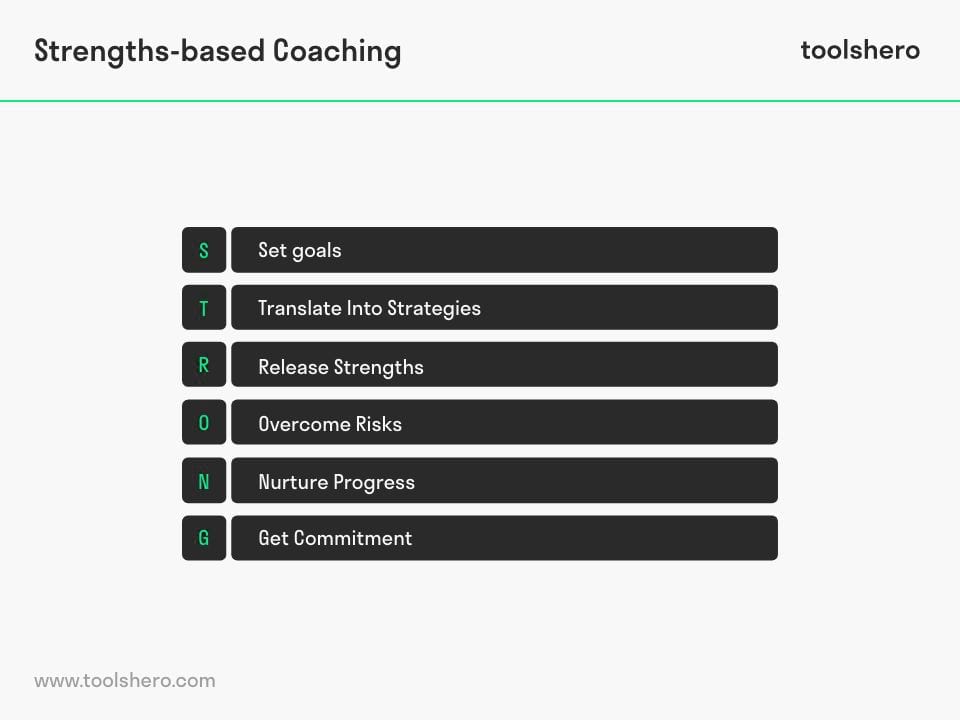Strengths Based Coaching explained

Strengths based coaching: This article explains the concept of strengths based coaching in a practical way. You can read about the meaning of this term, when coaching is practical and desirable, and various useful tips to get started with strengths-based coaching yourself. Enjoy reading!
What is strengths based coaching?
Strengths-based coaching is an approach to coaching that focuses on people’s strengths and positive qualities. This approach stems from positive psychology and has been gaining popularity in recent years.
Definition of Strengths-based coaching
The International Coaching Federation (ICF) defines coaching as “partnering with clients through a creative process that inspires them to maximize their personal and professional potential”. Another definition is that coaching is a non-directive way of guidance in which the coach provides a safe and trusted environment for the client so that they feel heard and understood. The Chartered Institute of Personnel and Development (CIPD) defines it as a non-directive form of development.
Strengths-based coaching mainly focuses on improving performance and developing the individual through a focus on qualities and skills. Personal factors can also be taken into account, but in many cases the focus is on work. It allows people to assess their strengths as well as opportunities for development. It is an important activity and a complex process that must be carried out by trained people.
Coaching is therefore not directive. That is, coaches don’t tell people what to do. They are extra careful about giving advice because advice is directive. It is also distinctly different from mentoring. Coaching is holding shoulder-to-shoulder conversations in which parties work together to solve problems of the coachee.
Mentorship is seen more as a way of transferring knowledge from one experienced party to another. Coaching is also different from supervision. Read more about this in our article about supervision.
Why are strengths important in coaching?
As noted, the strengths-based coaching style stems from positive psychology and focuses on people’s positive qualities and skills. Qualities are often taken for granted by the people who have them.
That is mainly because the predominant approach to coaching focuses on deficits as they predominate in the business environment. Strengths often remain underdeveloped. As a result, people almost forget their strengths. Even if they knew what their strengths were, they would not be quick to describe their strengths for fear of being seen as arrogant.
And that’s a shame. Strengths can provide a strong foundation to solve a variety of problems, complete tasks, and face and overcome challenges. They are also important for building relationships and gaining energy and motivation for development.
The coach who focuses on strengths
A coach who focuses on strengths mainly helps the client to identify these strengths themselves as a means of stimulating self-confidence and self-reliance. This helps the client solve problems in professional and personal life and achieve desired changes.
Risks
Focusing on strengths also has risks. The first risk is called overdrive. Overdrive occurs when using strengths are not appropriate for the situation. The consequence of this is that the right results are not achieved by focusing on these qualities. The second risk is called a drainer.
Drainers are a person’s strengths that draw all the energy out of the person and further weaken weak points. A good coach therefore not only focuses on the strengths, but also tackles things that can go wrong due to one of the risks mentioned above.
A strengths based coaching model
One of the most well-known coaching models is the GROW model. This model was developed in the 1980s, but has seen several modifications and additions since then. One of those adjustments is the adjustment to the STRONG model, aimed at strengths based coaching.
The G in the GROW model stands for goal and means that a certain goal is set prior to a coaching process. What do I want to achieve with this process? The R stands for reality: is the coachee already on his way to the goal or should he start now? How far along is the person in the process? O stands for exploring options. Which roads lead to the goal? Finally, the W stands for the way forward: this part tests the will or commitment of the coachee.
The phases of the STRONG model for strengths-based coaching
If the GROW model is so well-known and suitable for coaching, why apply change? As explained, strengths are often forgotten. That is why they are added to this model: the STRONG model.

Figure 1 – the STRONG model for strengths based coaching
The S stands for set goals. Like the GROW model, this model starts with setting personal or professional goals.
The second phase, the T, stands for translate into strategies. The coach helps the coachee in this phase to identify strategies to achieve the goal.
Phase 3 is characterized by identifying the main energy sources used to move towards the target: release strengths.
Phase 4 helps the person being coached to overcome risks.
The N of phase 5 stands for nurture progress. This is about measuring and tracking progress. Celebrate every win that gets you closer to the goal.
The last phase stands for get commitment. This phase is equal to the W from the GROW model. In this phase, the coach tries to determine how much the coachee is committed to achieving the goal.
Resume
In general:
- Coaching is a non-directive form of development
- Coaching is aimed at improving performance and general development of an individual
- Personal factors can be included, but often the focus is on professional aspects of life
- Coaching has both organizational and individual goals
- Coaching offers people the opportunity to assess their strengths and areas for development
In particular:
- Strengths-based coaching focuses mainly on people’s positive qualities and skills
- Strengths-based coaching helps the client to identify these strengths themselves
- Strengths-based coaching takes into account the risks of overdrive and drainers
- A useful model aimed at strengths-based coaching is the STRONG model
Now it is your turn
What do you think? Do you recognize the explanation about strengths-based coaching? Do you use coaching? Or are you a coach yourself? What other forms of coaching do you know? Which approach is your favourite? Do you have any tips or comments for people who need coaching? Or do you have tips or comments about this article? Or do you want to know more about a topic related to coaching? Let us know in the comments or fill out the contact form.
Share your experience and knowledge in the comments box below.
More information
- Burke, J., & Passmore, J. (2019). Strengths based coaching—a positive psychology intervention. Theoretical approaches to multi-cultural positive psychological interventions, 463-475.
- Haberlin, S. (2019). Something always works: a self-study of strengths-based coaching in supervision. Journal of Educational Supervision, 2(1), 38.
- Madden, W., Green, S., & Grant, A. M. (2020). A pilot study evaluating strengths‐based coaching for primary school students: Enhancing engagement and hope. Coaching researched: A coaching psychology reader, 297-312.
How to cite this article:
Janse, B. (2023). Strengths Based Coaching. Retrieved [insert date] from Toolshero: https://www.toolshero.com/management/strengths-based-coaching/
Original publication date: 03/03/2023 | Last update: 08/15/2023
Add a link to this page on your website:
<a href=”https://www.toolshero.com/management/strengths-based-coaching/”>Toolshero: Strengths Based Coaching</a>











